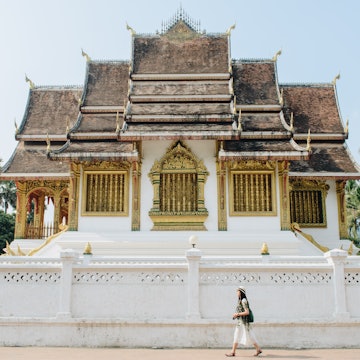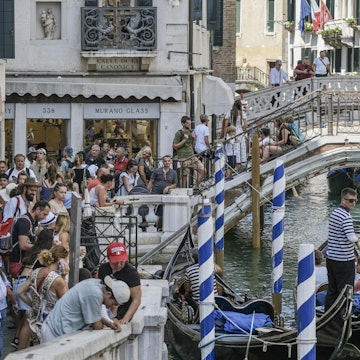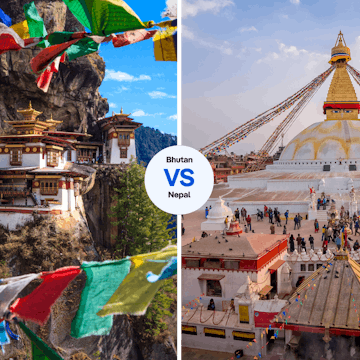

Get to know the cultural landscape and customs of Bhutan with this guide. Getty Images
Perched in the Himalayas between India and China, tiny Bhutan – with cliff-hanging monasteries, golden-roof temples and colorful prayer flags strung along trails and peaks – stands as the last Buddhist kingdom on earth.
Its careful tourism policy has allowed it to slowly open to the outside world without compromising its culture and traditions or degrading its pristine natural environment – two pillars of Gross National Happiness (GNH), a unique philosophy that guides the government of Bhutan.
This guide navigates Bhutan's cultural landscape, highlighting its local customs and quirks, as you plan your journey to the country known locally as Druk Yul, the Land of the Thunder Dragon.
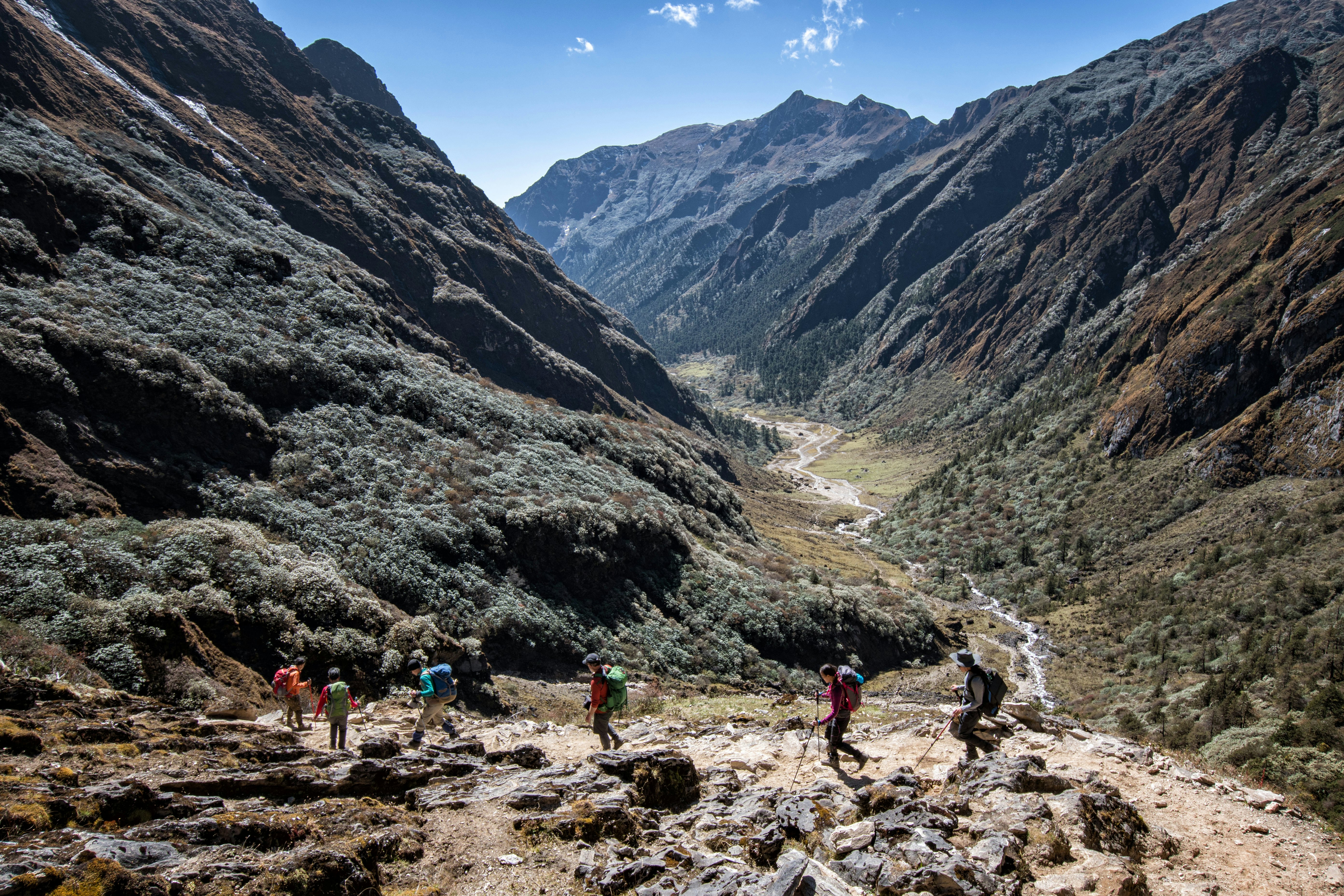
1. Independent travel is possible, but a tour operator is still the way to go
Bhutan has reduced its Sustainable Daily Fee (SDF) to US$100 (valid until August 2027) and no longer requires travelers to book an exorbitant all-inclusive tour package. There is also a 50% discount on SDF for kids ages six to 11, with no SDF for those under six. A one-time US$40 visa-application fee also applies.
The good news is that adventurous travelers planning a trip can now independently book accommodations, guides (mandatory for any journey beyond Thimphu and Paro) and transportation. Now you can also extend your visa while you’re in the country, and you can even drive your own car – for a fee.
However, for activities like trekking, attending festivals or specialized interests, such as birding, horse trekking or cycling, using a tour operator will enhance your overall experience – and is generally required. Lists of certified tour operators, guides and accommodations, including hotels and homestays, can be found on the official Bhutan Travel website.
2. Travel insurance is highly recommended
Proof of travel insurance is no longer needed in order to apply for a Bhutanese visa. However, as with any overseas travel, insurance is highly recommended and should cover the activities you plan to take on.

3. Book early for festivals and trekking
Locals argue that Bhutan is wonderful to visit year-round. There are no particular financial incentives for offseason travel in Bhutan, except for occasional hotel deals. Consider timing your trip with autumn and spring, when the most famous tsechus (religious dance festivals) take place and the leaves change color or the rhododendrons bloom, respectively. Book far ahead if you’re considering attending a celebration or going trekking.
Summer and winter are just as wonderful, with plenty of lesser-known festivals. But these seasons are not ideal if you’re planning a multiday trek, due to muddy trails and chilly camping. Few travelers come in the winter – considered an auspicious time to travel – so if you enjoy a crowd-free visit with crisp air, clear skies and perfect light for photography, this might be the best time for you. Plus, if you go for the December 17 National Day celebrations at Changlimithang Stadium in Thimphu, you may even get the chance to meet the king!
4. Only two airlines fly to Bhutan
Bhutan is served by two national airlines: Drukair and Bhutan Airlines. Because of the challenging landing conditions at Paro International Airport, surrounded by peaks as high as 5500m (18,000ft), only a select few pilots are authorized to fly there.
Direct flights to and from Paro connect you to various destinations, including Bangladesh (Dhaka), India (Bagdogra, Guwahati, Kolkata and New Delhi), Nepal (Kathmandu), Singapore, Thailand (Bangkok) and the UAE (Sharjah). While Bangkok and Delhi are common entry points, Kathmandu promises the most epic route, with glimpses of Mt Everest on clear days.
It’s not possible to check your luggage through to your final destination, so you’ll have to claim it before boarding your Bhutan connection.
You can also reach Bhutan overland via India, but not China, owing to border disputes.

5. Bhutan is the world’s first carbon-negative country
Bhutan gained global attention for being the world's first carbon-negative country. Being roughly the same size as Switzerland with only 10% of its population, a key factor in sustaining this achievement is a landmark constitutional mandate requiring the country to maintain a minimum of 60% forest coverage at all times. This is also supported by the environmental conservation pillar of GNH.
Additionally, plastic has been banned since 1999, though this is not regularly enforced. Nevertheless, do your part to keep the environment clean. There’s plenty of signage to remind you along the way: “Clean & beautiful environment is a feast to the soul,” says one placard en route to the Tiger’s Nest Monastery.
6. Bhutan is exceptionally safe
Bhutan maintains a low crime rate, with violent crime being scarce. As a single woman, I never felt unsafe on any of my trips to Bhutan. I was also never truly “alone” since I was always under the watchful eye of my guide or local friends. In recent years, the number of female guides has increased, which is more good news for solo women travelers.
7. Stay current on your vaccinations
No vaccines are required for entry into Bhutan. That said, you should stay up-to-date with your vaccines and consult a health-care professional at least eight weeks before your departure in case you need any boosters. Standard recommendations include vaccinations for hepatitis A and B, diphtheria, tetanus and typhoid, in addition to childhood vaccinations for measles-mumps-rubella and polio.
For longer trips, you may wish to consider vaccinations for Japanese encephalitis and rabies. Rabies is particularly noteworthy since friendly animals, like monkeys and dogs, can all transmit the virus, and untreated infection is fatal. If you are bitten by an animal, such as a stray dog, immediately go to the nearest health clinic and get a postexposure prophylaxis shot (you’ll need a total of four).

8. Minimize altitude sickness by taking time to adjust
Acute Mountain Sickness (AMS) can occur when travelers are above 2500m (8202ft). Given that the most commonly visited cities – Thimphu and Paro – are just 200m to 300m (656ft to 984ft) below that threshold, and that several treks in the Bhutanese Himalayas traverse mountain passes reaching heights of 5000m (16,404ft), AMS is a risk in Bhutan.
Ascend slowly, take rest days when needed, and if you begin to feel ill, stop. If it's not managed carefully, AMS can develop into life-threatening forms of altitude sickness, so pay close attention to how you're feeling. If your symptoms don’t ease, descend right away.
Planning tip: Due to the altitude, acclimatization may be necessary. It's worth waiting a few days or until the end of your trip – saving the best for last! – before embarking on the iconic Tiger’s Nest Monastery trek, which ascends about 1000m (3000ft). Make sure to schedule a traditional hot-stone bath afterward as well.
9. Pack a few medical essentials
Bring insect repellent to protect yourself from mosquito-borne illnesses when visiting in the summer months and in the southern regions. Because of climate change, Bhutan had its first nation-wide dengue epidemic in 2019. Dengue is deadly, and there is no vaccine to protect against it. The risk of contracting malaria in Bhutan is low.
Bhutan's average elevation is 3280m (10,760ft), making it one of the highest countries in the world. It also shares the same latitude as Texas, Egypt and the Bahamas, so the sun here is strong. Pack sunscreen and bring glasses to protect your eyes. It's also worth bringing Dramamine for car sickness and Diamox for altitude sickness – there are no tunnels in Bhutan and mountain roads are windy.
If you need diapers or tampons, bring them with you. Menstrual pads are available in stores and at select hotels and restaurants. Earplugs are recommended too – you'll need them at night when dogs start howling in downtown Thimphu.
10. Health care includes traditional remedies and Western medicine
Bhutan is sometimes called “Menjong,” which means “Land of Medicinal Herbs.” If you do find yourself feeling unwell during your trip, one option is a visit to Thimphu’s National Institute of Traditional Medicine. A member of staff will assess your pulse, temperature and ask about your bowels. In turn, you’ll receive a prescription for ayurvedic medicine crafted from local plants, all at no cost (a small donation is appreciated).
Alternatively, head to the nearest hospital or health clinic for treatment geared towards Western medicine. The Jigme Dorji Wangchuck National Referral Hospital, also known as the National Referral Hospital, in Thimphu is the biggest in Bhutan.

11. Bhutanese food is spicy and delicious
For decades, Bhutanese cuisine suffered in reputation because travelers were mostly exposed to mediocre buffets at their three-star hotels, featuring Indian, Chinese and continental dishes tailored precisely to their palates.
Thankfully, those buffets are slowly being phased out. The local cuisine, emphasizing fresh and seasonal ingredients, is on the up and up and proving to be extremely tasty, if you know where to go. Ask your tour operator or guide for recommendations.
And while Bhutanese cuisine is defined by hot chili peppers, such as with ema datse (chilies with cheese) and kewa datse (potatoes, chilies and cheese), dishes can be modified according to your taste if requested in advance. Still, you may need antacids.
12. Don’t drink the tap water
Tap water isn’t safe to drink in Bhutan unless it has been boiled or purified. Ask your hotel or guesthouse for boiled water, or purchase bottled water to have on your person.
Do, however, drink the local whiskey and lager – Bhutan has a flourishing craft-beer scene.
13. Follow local etiquette
"Kuzu zangpo la" means “hello” in Dzongkha, a Sino-Tibetan language and the national language of Bhutan, most commonly spoken in the western part of the country. Recite this while bowing (shaking hands is less common). The deeper the bow, the greater the respect.
Aside from Dzongkha (and the many other local languages and dialects), English is widely spoken because it is the language of instruction in schools. When Bhutanese converse in English, it is common to hear the word “la” at the end of a sentence or question as a sign of respect; for example, “Thank you, la.” Feel free to reciprocate.
If you find yourself invited into someone’s home and offered food, tradition dictates that you say the words “meshu meshu” while covering your mouth with your hands. After two or three offers, it is customary to accept. Similarly, if you are the one making an offer, or even giving a gift or tip, expect similar resistance. (Do consider giving a small tip if someone has invited you into their home and served you food or arra, a local spirit distilled from rice.)

14. Tipping is appreciated (but not mandatory)
Even if you’ve paid in advance for your all-inclusive trip, show appreciation to your guide and driver by tipping them at the end. On a trek, extend this gesture to the crew – ie the cook and any helpers. While 10–15% is normal, the amount and currency are up to you.
Tipping is not necessary at restaurants and hotels. A 10% service charge is already added to your bill when you dine out.
15. Head to Thimphu for Bhutan's nightlife
While most people are drawn to Bhutan for its serene landscapes, peaceful Buddhist monasteries and imposing fortresses (dzongs) such as Punakha Dzong, the country is hiding a buzzing nightlife and music scene equally worth exploring.
Thimphu's nightlife centers around Chang Lam near the stadium, featuring diverse options like the Zone (a popular bar), Mojo Park (a fantastic music venue, where the band Misty Terrace got its start), the Grey Area (Bhutan’s first gastropub) and nightclubs Space 34 and Vivacity, which are open to the wee hours.
16. It is legal to smoke in Bhutan, but be discreet
Bhutan was long known for its drastic yet visionary health law that forbade smoking and the trade of tobacco products. While the law was reversed in 2021, smoking must be done “out of sight,” ie behind buildings. The same goes for vaping. Vaping products are sold in a few places in Thimphu, but they’re not widely available.
Despite cannabis growing prolifically throughout the country, it remains illegal. Possession can land you in jail for up to one year. The only “drugs” produced in the country are traditional medicines.
17. Keep an open mind about local beliefs
Whether it’s migoi (yeti) sightings in Bhutan’s wild east, the significance of phalluses as symbols of protection or the flying tiger bringing Guru Rinpoche to the cave where the gravity-defying Tiger’s Nest Monastery now stands, folktales, myths and legends are an integral part of Bhutan’s culture and national pride – and believed to be true.
Approach Bhutan with an open mind. Travelers from the Global North may find it challenging to suspend logic and reason, but be kind when pushing back, and consider setting aside your preconceptions.
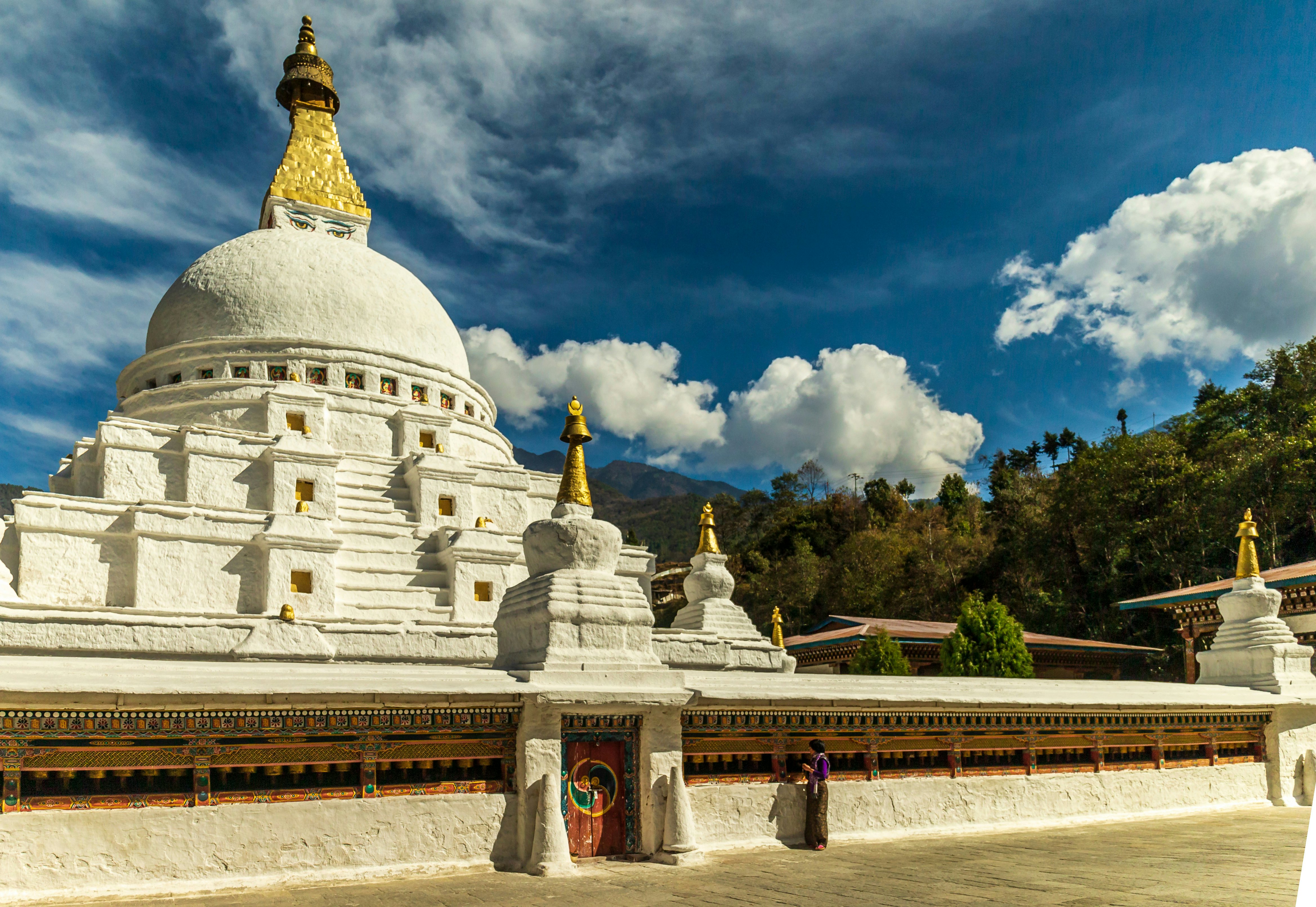
18. Pack layers, modest clothes and good boots
You’ll want layers for fluctuating temperatures and varying terrains, and modest clothing for entering temples and monasteries, including socks for cold temple floors. Aside from a good pair of hiking boots, bring a nicer shoe to wear with a gho or kira (Bhutanese national dress for men and women, respectively), should you decide to buy an outfit – highly recommended if you’re attending a festival or meeting with a dignitary. For inspiration, follow Bhutan Street Fashion on Instagram.
19. Carry cash and download these money apps
It’s easier to bring your own money (make sure the bills are crisp) rather than rely on and seek out ATM machines in the country. The official currency in Bhutan is the ngultrum, which is pegged 1:1 to the Indian rupee. Exchange at a bank or hotel so that you have small ngultrum notes for butter-lamp offerings, donations at religious sites, buying souvenirs, and tipping your guide, driver and trekking crew. Plus, you'll need small bills for entrance fees.
Most Bhutanese businesses accept cash or payments through either goBoB or the BNB MyPay apps. Foreign visitors can activate the app by downloading it from Google Play or Apple's App Store, inserting a local SIM purchased at the airport and funding the digital wallet with their credit or debit card. While goBoB is more popular among locals, some tour operators argue MyPay is better for foreigners because it is linked to more international card networks and is powered by Stripe.
20. Pick up a SIM card on arrival
SIM cards used to be challenging to obtain, but now you can easily get them upon arrival at Paro International Airport. You can also rent a pocket wi-fi device there – useful if you’re planning to visit remote regions and need to be online.

21. Understand the etiquette at religious sites
When visiting Buddhist monasteries, nunneries and temples, observe proper etiquette: remove shoes and hats, wear clothing that covers your shoulders and knees, refrain from photography in altar rooms, avoid pointing, never lean against a stupa and consider leaving a small donation on the altar or with a monk. If seeking a blessing, it's customary to offer a small donation.
Be it in a car or on foot, circumambulation of a Buddhist temple or shrine, such as a stupa or chorten, must always be clockwise. To go counterclockwise, whether it’s out of ignorance or on purpose, is seen as offensive, culturally insensitive and unlucky. Similarly, prayer wheels, which help purify karma, should be spun in a clockwise direction.
22. Don’t bargain hard
Unlike some other places in Asia where you’re expected to haggle, Bhutan’s market scene is a lot more straightforward. You typically pay the price that’s listed – aggressive negotiating tactics are a foreign concept.
That said, be prepared to spend a pretty penny if you plan to shop. You'll be drawn to abundantly colorful textiles crafted from natural fibers, like silk and cotton. These can take months to produce, so prices reflect the meticulous work and cultural richness woven into each piece, often by women. Geometric yathras, textiles made of yak wool and commonly found in central Bhutan’s Bumthang region, are a budget-friendly option.
23. Consult the lunar calendar
Since Bhutan follows the lunar calendar, dates for Buddhist festivals, like tsechus, change from year to year. However, some cultural festivals, like Bhutan National Day and the Black Necked Crane Festival in Phobjikha Valley, follow the Gregorian calendar and therefore stay the same.









